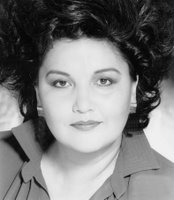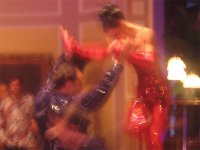mary & madeleine

 Of course, those who spent time on the set of Roxana will know Mary and Madeleine as the film's inspired make-up and hair design team. One of the great things about a blog is always having the opportunity to go back and take a closer look at some of the work that has been running in the background of a project like this one and no less valuable to its end result. In considering the visual aspects of Roxana, I have taken time out in the past to chat with Rhonda Moscoe and Debra Hanson about set and costumes. Now as we wait for the opportunity to report on how post-production is moving, there is time to explore the work of others. Where better to start than hair and make-up? Madeleine Russell and Mary Monforte designed the look of the transportive and emotional faces we will see in tight close-ups of the film. Besides the actors themselves, the work of these artists will be what creates an indelible impression.
Of course, those who spent time on the set of Roxana will know Mary and Madeleine as the film's inspired make-up and hair design team. One of the great things about a blog is always having the opportunity to go back and take a closer look at some of the work that has been running in the background of a project like this one and no less valuable to its end result. In considering the visual aspects of Roxana, I have taken time out in the past to chat with Rhonda Moscoe and Debra Hanson about set and costumes. Now as we wait for the opportunity to report on how post-production is moving, there is time to explore the work of others. Where better to start than hair and make-up? Madeleine Russell and Mary Monforte designed the look of the transportive and emotional faces we will see in tight close-ups of the film. Besides the actors themselves, the work of these artists will be what creates an indelible impression.I caught up with the divine Miss(es) "M" and here are their thoughts:
 How would you describe the hair and make-up look of Roxana, in terms of defining style?
How would you describe the hair and make-up look of Roxana, in terms of defining style?Mary: This is a stylized look reminiscent of the 50s and 60s.
Madeleine: (that's her, just visible attending to Greta on set at left) Hair styles in the 50's were defined by a distinctive look such as hair close to the head, curls, softness around the face and waves. Hair in the 60s was bigger: flips,Vidal Sasoon geometric cuts, beehives, more hairspray and teasing .
How does the work of each of you affect the choices the other makes?
Mary: they must coincide with each other and compliment the entire look, including the clothing as well. For instance, the outfit should somehow blend with make up colours and avoid an obvious clash. Also, in period looks, certain colours are more distinct to that era. These are things that are common knowledge to the costume/make-up departments during research and prep for the piece.
Madeleine: On each hair and make-up change, Mary and I worked closely and consulted each other on what we had planned for each scene, making sure both were suitable for the story and complmentary to the actor.
What are/were the challenges of creating a look for a project such as this one?
Madeleine: The challenge before the shoot was the reseach: spending many hours over books and also collecting data from the internet, then deciding all the period hairstyles for the principle actors and dancers which took days to acomplish. What wigs and hairpieces to use, colours and length of hair as final choices.
Mary: keeping the looks in sync with the period was a definite challenge, yet keeping them stylized as per Moze's request.
 What cues did you receive from Moze and/or how do you generally interact with the director of a project?
What cues did you receive from Moze and/or how do you generally interact with the director of a project?Madeleine: First let me tell you Moze is a dream director and fun to work with! After our collected reseearch, Mary and I met with Moze to discuss the look he wanted for the show which was highly stylized and edgey. He described each character to us and in general his vision for Roxana, and during production we consulted many times and found we were on the same page.
Mary: Part of the job is being able to accomodate the director's vision as well as keeping the talent happy. Moze wanted Roxana's look to always be a little overdone as per her character.
How much are you impacted (generally, in any situation) by the work being done by the costume designer?
Madeleine: For me the costume designer is very important. I have to see the costume before I can get a clear vision of a hairstyle. The collars and necklines are very important, as I must incorporate a workable style. There has to be a good balance in hair and costume.
Mary: The costume designer has the power to change any looks which do not meet with their designs in general: in dance pieces, the costumes may impact the make-up because fabric may be rubbing against the face and become soiled, smudging the make-up also. These things are always a concern for both departments and I am constantly aware and ready to make any adjustments/repairs.
 Roxana covers a number of different eras, closely connected. How did you manage to make each feel so distinct?
Roxana covers a number of different eras, closely connected. How did you manage to make each feel so distinct?Mary: Roxana's looks are always glamorous, so the hair really helped to define different eras as well as the clothing. Madeleine: I chose very distinct hair designs for the three periods we were in: 1957, 1962 and 1967.
Which character in the movie was the easiest to find a look for? Which was the hardest?
Madeleine: The male actors were the easiest to design for. Greta (Roxana) was the most challenging because she was in every scene and every era. I used hairpieces and wigs for her various dances and scenes. In some of the love scenes we used her own hair for softer sexier looks.
Mary: the easiest was Roxana's young daughter (Susan) who required minimal make-up. In general, I didn't find any other of the character's looks really hard.
 What are the unique challenges of doing your work in combination with dance?
What are the unique challenges of doing your work in combination with dance?Mary: Ensuring that the make-up stays on while the dancer is on camera performing and sweating.
Madeleine: Making sure that wigs and hairpieces are secure on the heads for the dances.
What will you remember most in relationship to your work on Roxana..?
Madeleine: That it was such a beautiful production to watch during filming. The cast was amazing to work with. Working with Moze and helping to bring his vision to life.
Mary: I love dance. I studied modern dance in my younger years, so it's always been a passion of mine. It's always a great experience to meet these artists and collaborate with them, the outcome being a great performance.















